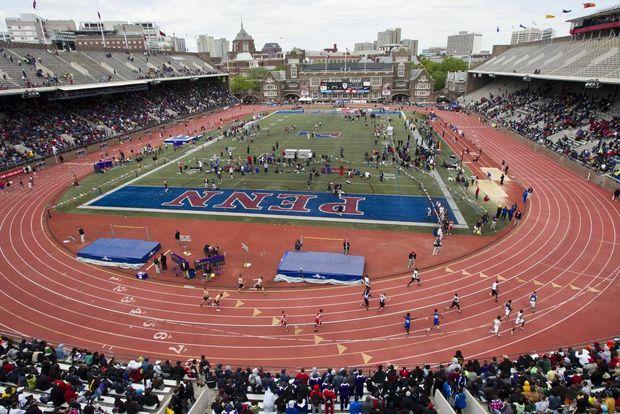The Penn Relays is the oldest and largest track and field competition in the United States.
Hosted annually by the University of Pennsylvania at Philadelphia’s Franklin Field since 1895, the relays take place during the final week in April – known as Carnival Week. The meet includes more than 15,000 participants from high schools, colleges and track clubs throughout North America and abroad – most notably Jamaica – competing in more than 300 events over five days. The Penn Relays popularized relay races and is one of the most prestigious events in track and field. Attendance tops 100,000 over the final three days of the meet and it has been known to attract over 50,000 spectators for the final day of competition, which is always the last Saturday in April.
In 1893, the University of Pennsylvania Track and Field Committee wanted to spice up their spring handicapped meet and came up with the idea of running a relay race. The event would consist of a two four-man teams, each running a quarter-mile lap around the track — one after the other — in an event known today as the 4 x 400m Relay. During the 1893 meet, Penn ran against Princeton. The Tigers won in 3:34, beating the Penn team by eight yards, and the relay race was born.
The first Penn Relay Carnival, held April 21, 1895, at Franklin Field, was a huge success, attracting more than 5,000 spectators. Nine relay races were run, with only two teams in each race. Four of the events involved high school athletes, while the other five included collegiate runners. The only relay event run at the time was the Mile Relay, also known as the 4 x 440-yard Relay. Participating colleges in the inaugural Carnival included Cornell, Columbia, Lafayette, Lehigh, Rutgers, Swathmore, CCNY, NYU and, of course, Penn.
Franklin Field was dedicated in April 1895 specifically for the first Penn Relay Carnival. The historic stadium is the site of the nation’s first scoreboard and loudspeaker. It is the oldest venue that functions as both a football field and track and field stadium. In 1903, Franklin Field became the first permanent college stadium in the country and is the first to feature a “horseshoe” design. The iconic venue is rich in history, as it is America’s first two-tiered stadium and site of the first college football game broadcast on radio [1921] and commercial television [1939]. In addition to serving as home for Penn athletics teams, Franklin Field has hosted the Army-Navy Game on more than 35 occasions. The venerable stadium and was the site of Vince Lombardi’s only playoff loss as coach of the Packers when, playing on their home field, Norm Van Brocklin led the Philadelphia Eagles to a 17-13 victory over Green Bay in the 1960 NFL title game. Franklin Field was rebuilt to its present-day form in 1922. A ten-lane synthetic track was added in 1967 and the football field was converted to artificial turf in 1969.
The Penn Relay Carnival holds events for high school, college, Olympic developmental, Masters, Special Olympics, and blind athletes. Relays are also included for elementary, junior high, and middle schoolers. The 2012 meet featured 116 events and included more athletes than any track and field event in the world. Second only to the Olympics in prestige and public awareness, the Carnival has hosted some of the greatest performers in track and field history, including Jim Thorpe, Jesse Owens, Al Oerter, Edwin Moses and Wilma Rudolph. Only one world record has been set at the Penn Relays. In 2000, Marion Jones anchored the U.S. team in the 4 x 200m in 1:27.46. Meet records are currently held by several notable Olympians, including Leroy Burrell, Micheal Johnson, Allyson Felix and Mary Decker. In 2010, the relays featured a “USA v The World” program, pitting American teams against elite runners such as Jamaica’s Usain Bolt and Shelly Ann Fraser. The 2010 Carnival set a single-day attendance mark of 54,310 on Saturday and a record three-day total of 117,346.
Entries increased fourfold from the inaugural Penn Relay meet to the second, held in 1896. The Five-Mile Relay was added that year, and the 4 x 800 joined the 1897 lineup. In 1898, the University of Chicago became the first entrant from the Midwest and, by 1900, the relays included 100 Yard, 220 Yard, 120 Yard High Hurdle races as well as a host of new field events. Carnival was put into the event’s name in 1910 due to the carnival-like atmosphere created by the meet’s tent camp. Relay event runners exchanged batons for the first time in 1913. The event became international the following year, when Oxford University competed for the first time. The Penn Relay Carnival served as track and field’s national championships until 1921, when the NCAA began hosting the meet.
Women competed in the Penn Relays for the first time in 1962. The Marathon race was added to the program in 1973, and event distances were converted from yards to meters three years later. In 1977, electronic timing replaced the former, hand-held version. Increasing interest in the relays brought more entrants, and with more participants came the need for more races. In order to handle the growing demand, the Penn Relays Carnival was expanded to a three-day meet in 1978.
The top high school and college teams compete in the finals of “Championship of America” relays, with the winning team in each event receiving The Wheel. First awarded at the 1925 Penn Relay Carnival, the trophy is an 18-inch bronze plate mounted on a wooden circle. The design on the plaque – and other medals awarded during the relays — was created by Dr. R. Tait McKenzie, a Canadian physician who taught at Penn. A boyhood friend of basketball inventor Dr. James Naismith, McKenzie was the father of modern physiotherapy. The picture on the awards features Penn founder, Benjamin Franklin, sitting in his library chair holding a laurel sprig in his hand. Relay Carnival is inscribed on the wooden portion of the plaque above the bronze picture, with University of Pennsylvania inscribed below. Individuals on winning relay teams each receive a gold watch, as do college and high school individual event winners. Silver medals are awarded to second-place finishers, while third, fourth and fifth place earn bronze.
The 123rd Penn Relay Carnival gets underway tomorrow at the University of Pennsylvania’s Franklin Field.









